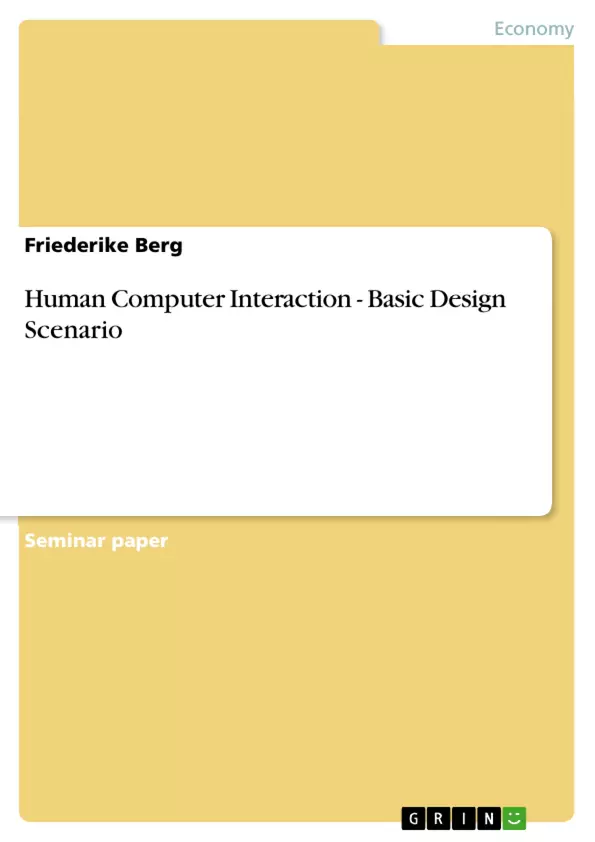I am working for a start-up developing a new real-time sports app for the Apple watch that shares automatically your score such as your number of the shot hoop when you play basketball and let you simultaneously compete with other players without being at the same physical location. It also will contain features in-app to simplify contacting other players who are in the same neighborhood to schedule a spontaneous game. The company has six employees from which one is part of my design team. The financial resources are limited that also leads to high time pressure. The problem I am trying to solve is how the app can track a player’s score without the necessary interaction or input of the player.
Inhaltsverzeichnis (Table of Contents)
- Basic Design Scenario
- Good method of prototyping: True Programming
- Poor method of prototyping: Storyboarding
- Good method of evaluation: Heuristic Evaluation
- Poor method of evaluation: Cognitive Walkthrough
Zielsetzung und Themenschwerpunkte (Objectives and Key Themes)
This document outlines the prototyping and evaluation methods for a real-time sports app developed for the Apple Watch. The app aims to track a player's score during a basketball game without requiring user interaction. The document explores the rationale behind choosing True Programming for prototyping and Heuristic Evaluation for evaluation.
- Tracking player scores without user interaction
- Evaluating the app's accuracy and usability
- Prioritizing functionality over user interface
- Using familiar user interfaces from existing fitness apps
- Balancing limited resources with high-quality development
Zusammenfassung der Kapitel (Chapter Summaries)
- Basic Design Scenario: This chapter introduces the app's functionality, the development team, and the challenges posed by limited financial resources. The app aims to track a player's score automatically during a basketball game. The focus is on developing a system that doesn't require the player to manually input their score. The chapter outlines the reasons for choosing True Programming for prototyping and Heuristic Evaluation for evaluation.
- Good method of prototyping: True Programming: This section explains why True Programming is the best choice for prototyping the app. It emphasizes the need for a functional prototype that accurately reflects the app's core functionality, especially for tracking scores without user interaction. The chapter highlights the importance of testing the prototype in real-world settings to ensure its effectiveness.
- Poor method of prototyping: Storyboarding: This section explains why storyboarding is not a suitable prototyping method for the app. The argument is that storyboarding primarily focuses on user interactions, which are less important in this case. The app's core functionality, which involves automatic score tracking, cannot be adequately addressed through storyboarding.
- Good method of evaluation: Heuristic Evaluation: This section explains why Heuristic Evaluation is the best choice for evaluating the app's usability and effectiveness. The chapter emphasizes the need for real-user testing to identify any unforeseen complications and ensure the app provides a positive user experience. The focus is on evaluating the accuracy, usability, and effectiveness of the automatic score-tracking system.
- Poor method of evaluation: Cognitive Walkthrough: This section explains why Cognitive Walkthrough is not a suitable evaluation method for the app. The argument is that the user's task (shooting hoops) is straightforward, and a cognitive walkthrough would not provide valuable insights into the user's behavior on the basketball court.
Schlüsselwörter (Keywords)
The primary focus of this document is on the development of a real-time sports app for the Apple Watch. The app aims to track a player's score automatically during a basketball game without requiring user interaction. The document explores the rationale behind choosing True Programming for prototyping and Heuristic Evaluation for evaluation. Keywords related to the document include: real-time sports app, Apple Watch, automatic score tracking, True Programming, prototyping, Heuristic Evaluation, user experience, usability, and limited resources.
- Citar trabajo
- Friederike Berg (Autor), 2018, Human Computer Interaction - Basic Design Scenario, Múnich, GRIN Verlag, https://www.grin.com/document/505680



